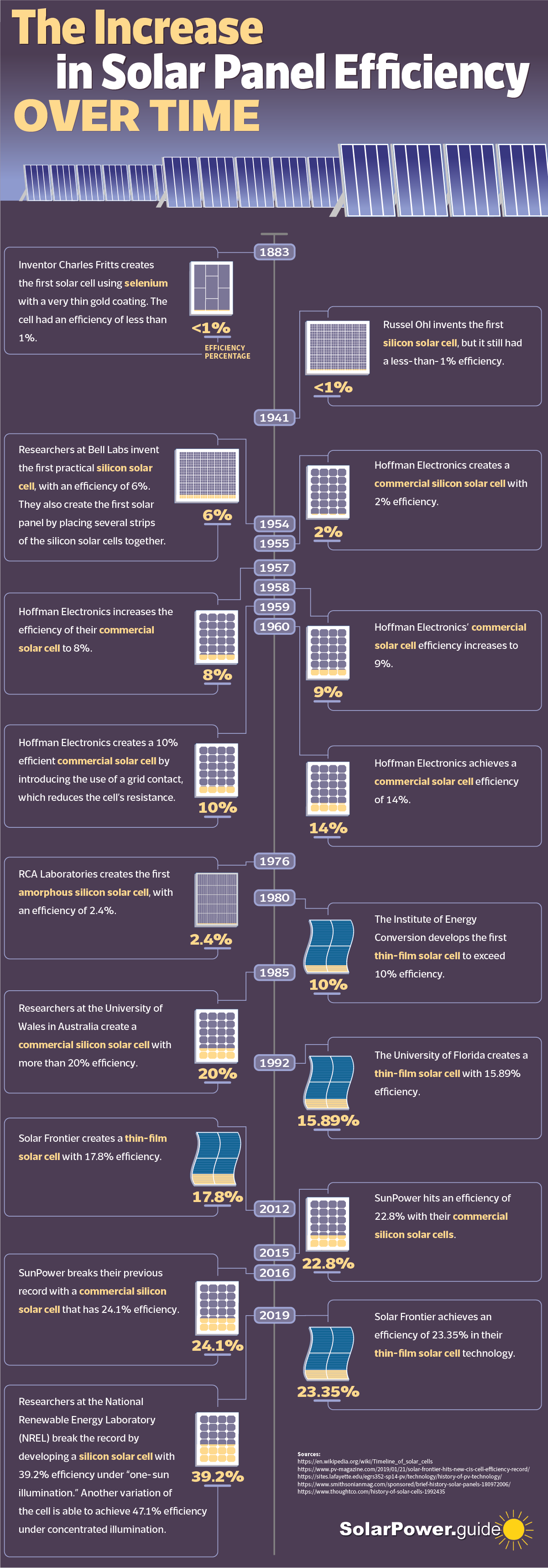The Increase in Solar Panel Efficiency Over Time
Solar panel efficiency has grown quite a bit since the very first solar cells were created back in the 1880s. Back then, the solar cell efficiency was incredibly low, less than 1%, and today, scientists are creating high-efficiency solar panels that can reach almost 50% efficiency! Unfortunately, the average efficiency of solar panels that are sold on a commercial level is roughly half that. But after seeing the advances that have been made in terms of solar energy efficiency over the past couple of decades, we have high hopes that this higher-solar-efficiency technology will be available to the masses sooner rather than later. Having the ability to reach a solar power efficiency of 50% would go a long way in reducing our carbon footprints. Below, you’ll find a timeline by Solar Power Guide of how solar panel efficiency over time has increased thanks to new emerging technologies and the tireless work of researchers and scientists in the field.
Click the below image to view full-size.

Simply copy and paste the code from the box below to share.
How Efficient Were the First Solar Panels?
The first solar panels had a very low solar efficiency of less than 1%. The process of producing an electric current from light exposure, called the photovoltaic effect, was discovered in the 1830s, but it wasn’t until later on in the 19th century that solar-powered devices would begin to be created. Charles Fritts, an inventor from New York, was the first to create a solar cell, and he did so by coating selenium with a very thin layer of gold. His selenium solar cell was only able to achieve a solar energy efficiency of about 1%, but it was the spark that began to push other scientists and researchers to improve upon his solar panel efficiency calculation in order to create their own high-efficiency solar cells.
How Has Solar Panel Efficiency Increased Over Time?
Solar panel efficiency over time has steadily increased from its meager beginnings of barely hitting 1%. It wasn’t until 1954 that we really began to see an increase in solar cell efficiency when Bell Labs created the first silicon solar cell, which was able to reach almost 6% efficiency. The following year, Hoffman Electronics created the first commercial silicon solar cell, with which they achieved 2% efficiency. Hoffman continued to improve upon the solar efficiency of their commercial solar cell each year until 1960, when they were finally able to achieve 14% efficiency. Since then, the average efficiency of solar panels has slowly increased, with new types of solar cells being introduced along the way.
What is the efficiency of solar panels today? The most efficient solar panels on the market today have an efficiency of about 22.8%. While that may not seem like much, today’s solar panels are far more powerful than the ones created more than 60 years ago. There’s also hope for a big increase in solar panel efficiency in the near future, as researchers at the National Renewable Energy Laboratory broke the solar cell efficiency record by creating a silicon solar cell with a high efficiency of 39.2%
Are you interested in powering your home more efficiently with solar energy? Using the correct-sized solar panel can make a big difference in its efficiency. Use our solar panel size guide to find the right size for your home, business, or recreational vehicle.
Timeline of Solar Panel Efficiency Over Time
- 1883: Inventor Charles Fritts creates the first solar cell using selenium with a very thin gold coating. The cell has an efficiency of less than 1%.
- 1941: Russel Ohl invents the first silicon solar cell, but it still has a less-than-1% efficiency.
- 1954: Researchers at Bell Labs invent the first practical silicon solar cell, with an efficiency of 6%. They also create the first solar panel by placing several strips of the silicon solar cells together.
- 1955: Hoffman Electronics creates a commercial silicon solar cell with 2% efficiency.
- 1957: Hoffman Electronics increases the efficiency of their commercial solar cell to 8%.
- 1958: Hoffman Electronics commercial solar cell efficiency increases to 9%.
- 1959: Hoffman Electronics creates a 10% efficient commercial solar cell by introducing the use of a grid contact, which reduces the cell’s resistance.
- 1960: A solar cell efficiency of 14% is achieved by Hoffman Electronics.
- 1976: RCA Laboratories creates the first amorphous silicon solar cell, with an efficiency of 2.4%.
- 1980: The Institute of Energy Conversion develops the first thin-film solar cell to exceed 10% efficiency.
- 1985: Researchers at the University of Wales in Australia create a commercial silicon solar cell with more than 20% efficiency.
- 1992: The University of Florida creates a thin-film solar cell with 15.89% efficiency.
- 2012: Solar Frontier creates a thin-film solar cell with 17.8% efficiency.
- 2015: SunPower hits an efficiency of 22.8% with their commercial solar cells made from silicon.
- 2016: SunPower breaks their previous record with a commercial silicon solar panel that has 24.1% efficiency.
- 2019: Solar Frontier achieves an efficiency of 23.35% in their thin-film solar cell technology.
- 2019: Researchers at the National Renewable Energy Laboratory (NREL) break the record by developing a silicon solar cell with 39.2% efficiency under “one-sun illumination.” Another variation of the cell is able to achieve 47.1% efficiency under concentrated illumination.